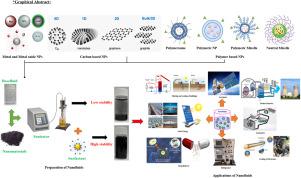Physics Reports ( IF 30.0 ) Pub Date : 2021-07-19 , DOI: 10.1016/j.physrep.2021.07.002 Zafar Said 1, 2 , L. Syam Sundar 3 , Arun Kumar Tiwari 4 , Hafiz Muhammad Ali 5, 6 , Mohsen Sheikholeslami 7, 8 , Evangelos Bellos 9 , Hamza Babar 10

|
In the past decade, nanotechnology’s rapid developments have created quite a lot of prospects for scientists and engineers to check up. Nanofluid is one of the remarkable consequences of such progression. Nanofluids are engineered by suspending nanoparticles with average sizes below 100 nm in traditional heat transfer fluids such as water, oil, ethylene glycol, etc. Nanofluids are considered to offer substantial advantages over conventional heat transfer fluids. When dispersed uniformly and suspended stably in base fluids, a minimal amount of nanoparticles can significantly improve the thermal properties of host fluids. Present work attempts to address this challenge considering state-of-the-art advances in understanding, characterizing, and mitigating issues about nanofluids’ stability. Stable and highly conductive nanofluids are produced by generally, one step and two step production methods. Both approaches of creating nanoparticle suspensions suffer from nanoparticles’ agglomeration, which is a critical issue in all technologies involving nanopowder. Therefore, numerous numerical models and the principal physical phenomena affecting the stability (fundamental physical principles that govern the interparticle interactions, clustering and deposition kinetics, and colloidal stability theories) have been analyzed. Concerning the particles’ dynamic motion, the importance of different forces in nanofluid flows that exist in particulate flows such as drag, lift (Magnus and Saffman), Brownian, thermophoretic, Van der Waals, electrostatic double-layer forces are considered.
Moreover, an overview of nanofluids’ thermophysical properties, physical models, and heat transfer models are included in this work. To understand the unexpected discoveries and overcome classical models’ limitations, several investigators have proposed new physical concepts and mechanisms and developed new models to enhance the transport properties. In the present work, the wide-ranging structural evolution of nanofluids has been discoursed thoroughly by sketching out a gargantuan depiction of the diminutive biosphere of nanofluids through a brief review of some foremost chronological milestone such as the concepts of nanofluids, the preparations and performances of nanofluids, conductivity, viscosity, and density correlations of nanofluids, and potential applications and benefits of nanofluids. Also, different kinds of modeling and essential slip mechanisms of constructing heat transfer modeling of nanofluids have been discussed comprehensively in this study. Potential novel 2D materials as nanofluids have also been discussed and reported. A brief overview of the potential applications utilizing nanofluids have been reviewed, and future research gaps have been reported. Furthermore, recommendations were drawn regarding current knowledge gaps and future research directions to overcome the physical phenomenon, stability, thermophysical properties, overview of some applications, and the limitations hindering these nanofluids’ deployment. The review is presumed to be valuable for scholars and researchers working in the area of numerical simulations of nanofluids and experimental aspects and help them understand the fundamental physical phenomena taking place during these numerical simulations and experiments and explore the potential of nanofluids both in academia and industry.
中文翻译:

纳米流体稳定性、动态运动、热物理特性、热传输、应用和挑战背后的基本物理现象的最新进展
近十年来,纳米技术的飞速发展为科学家和工程师创造了相当多的前景。纳米流体是这种进展的显着后果之一。纳米流体是通过将平均尺寸低于 100 nm 的纳米粒子悬浮在传统的传热流体(如水、油、乙二醇等)中而设计的。纳米流体被认为比传统的传热流体具有显着的优势。当均匀分散并稳定悬浮在基液中时,极少量的纳米颗粒可以显着改善主体流体的热性能。考虑到在理解、表征和减轻有关纳米流体稳定性的问题方面的最新进展,目前的工作试图解决这一挑战。稳定且高导电性的纳米流体通常通过一步法和两步法制备。两种制备纳米颗粒悬浮液的方法都存在纳米颗粒的团聚问题,这是所有涉及纳米粉末的技术中的一个关键问题。因此,已经分析了许多数值模型和影响稳定性的主要物理现象(控制粒子间相互作用、聚类和沉积动力学以及胶体稳定性理论的基本物理原理)。关于粒子的动态运动,考虑了颗粒流中存在的纳米流体流中不同力的重要性,例如阻力、升力(马格努斯和萨夫曼)、布朗力、热泳力、范德华力、静电双层力。两种制备纳米颗粒悬浮液的方法都存在纳米颗粒的团聚问题,这是所有涉及纳米粉末的技术中的一个关键问题。因此,已经分析了许多数值模型和影响稳定性的主要物理现象(控制粒子间相互作用、聚类和沉积动力学以及胶体稳定性理论的基本物理原理)。关于粒子的动态运动,考虑了颗粒流中存在的纳米流体流中不同力的重要性,例如阻力、升力(马格努斯和萨夫曼)、布朗力、热泳力、范德华力、静电双层力。两种制造纳米颗粒悬浮液的方法都存在纳米颗粒的团聚问题,这是所有涉及纳米粉末技术的关键问题。因此,已经分析了许多数值模型和影响稳定性的主要物理现象(控制粒子间相互作用、聚类和沉积动力学以及胶体稳定性理论的基本物理原理)。关于粒子的动态运动,考虑了颗粒流中存在的纳米流体流中不同力的重要性,例如阻力、升力(马格努斯和萨夫曼)、布朗力、热泳力、范德华力、静电双层力。已经分析了许多数值模型和影响稳定性的主要物理现象(控制粒子间相互作用的基本物理原理、聚类和沉积动力学以及胶体稳定性理论)。关于粒子的动态运动,考虑了颗粒流中存在的纳米流体流中不同力的重要性,例如阻力、升力(马格努斯和萨夫曼)、布朗力、热泳力、范德华力、静电双层力。已经分析了许多数值模型和影响稳定性的主要物理现象(控制粒子间相互作用的基本物理原理、聚类和沉积动力学以及胶体稳定性理论)。关于粒子的动态运动,考虑了颗粒流中存在的纳米流体流中不同力的重要性,例如阻力、升力(马格努斯和萨夫曼)、布朗力、热泳力、范德华力、静电双层力。
此外,本文还概述了纳米流体的热物理特性、物理模型和传热模型。为了理解意外发现并克服经典模型的局限性,一些研究人员提出了新的物理概念和机制,并开发了新模型来增强输运特性。在目前的工作中,通过简要回顾一些最重要的时间里程碑,如纳米流体的概念、制备和性能,勾勒出纳米流体微小生物圈的巨大描述,彻底讨论了纳米流体的广泛结构演变。纳米流体、纳米流体的电导率、粘度和密度相关性,以及纳米流体的潜在应用和益处。还,本研究全面讨论了构建纳米流体传热模型的不同类型的建模和基本滑移机制。还讨论和报道了潜在的新型 2D 材料作为纳米流体。对利用纳米流体的潜在应用进行了简要概述,并报告了未来的研究差距。此外,还就当前的知识差距和未来的研究方向提出了建议,以克服物理现象、稳定性、热物理特性、一些应用的概述以及阻碍这些纳米流体部署的局限性。



























 京公网安备 11010802027423号
京公网安备 11010802027423号